A mathematical model of malaria transmission with hospitalized compartment
Main Article Content
Abstract
This study aimed to consider the malaria model of the human and mosquito populations and investigate the equilibrium points of the model at disease free equilibrium point and endemic equilibrium point. Moreover, the stability of the equilibrium points was considered on the conditions of basic reproduction number by using Routh-Hurwitz stability criterion. The results showed that if
<1 then disease free equilibrium point was locally asymptotically stable and if
>1, with a sufficient condition then endemic equilibrium point was locally asymptotically stable. The numerical solutions were studied by defining the parameters from the literature researches of the spread of malaria and our assumptions. The numerical analysis revealed that the basic reproduction number at the stability of disease free equilibrium point was
= 0.7006 which indicated that there was no outbreak of the disease. Finally, if we assume that the proportion of human population bitten by mosquitoes and infected by the virus increases, the probability of mosquito population infected with the virus increased, the recovery rate of hospitalized humans decreased and the rate of hospitalization decreased. Therefore, the results showed that at stability of endemic equilibrium point, the basic reproduction number was
= 2.50 and the condition which satisfy the Routh-Hurwitz stability criterion for
implied that there was an outbreak of the disease.
Article Details
Published manuscript are the rights of their original owners and RMUTSB Academic Journal. The manuscript content belongs to the authors' idea, it is not the opinion of the journal's committee and not the responsibility of Rajamangala University of Technology Suvarnabhumi
References
Barnett, S., & Cameron, R. G. (1985). Introduction to mathematical control theory. Oxford: Clarendon.
Chen, Z., & Huang, J. (2014). Stabilization and regulation of nonlinear systems a robust and adaptive approach. Switzerland: Springer.
Chinviriyasit, W. (2011). Mathematics to forecast disease outbreaks. Mathematical Journal, 56(638-640), 91-97. (in Thai)
Chitnis, N., Hyman, J. M., & Cushing, J. M. (2008). Determining important parameters in the spread of malaria theory the sensitivity analysis of a mathematical model. Bull. Math. Biol., 70(5), 1272-1296.
Department of Disease Control. (2018). Malaria. Retrieved 20 August 2019, from http://malaria.ddc.moph.go.th/malariaR10/index_newversion.php (in Thai)
Department of Disease Control. (2019). Situation of malaria in Thailand. Retrieved 20 August 2019, from http://malaria.ddc.moph.go.th/malariaR10 (in Thai)
Goenchanart, Ut. (n.d.). Computer engineering mathematic II. Retrieved 15 November 2019, from http://cpe.rsu.ac.th/ut/courses/T2-57/cpe332/ download/CPE332%20Ed3%20Pt%20III.pdf (in Thai)
Ishikawa, H., Ishii, A., Nagai, N., Ohmae, H., Harada, M., Suguri, S., & Leafasia, J. (2003). A mathematical model for the transmission of Plasmodium vivax malaria. Parasitol. Int., 52, 81-93.
Jirawatphanit, A., Veeraprasertsakul, A., Hanchengchai, S., & Jai-oon, J. (2017). A mathematical model SEIR for controlling the spread of chickenpox
by education campaign. Phuket Rajabhat University Academic Journal, 13(2), 254-274. (in Thai)
Jongwutiwes, S. (2011). Malaria vaccine. Retrieved 1 November 2019, from http://pidst.or.th/userfiles/41_วัคซีนป้องกันโรคมาลาเรีย.pdf (in Thai)
Kaojarern, S., Wilairatana, P., Krudsood, S., Suputtamongkol, Y., Chetchotisakd, P., Prayoonwiwat,…Vijaykadga, S. (2014). Guidelines practice for the treatment of malaria patient in Thailand 2014. Nonthaburi: The Agricultural Co-operative Federation of Thailand. (in Thai)
Khalil, H. (2014). Nonlinear systems. London: Pearson.
Laxminarayan, R. (2004). Act now or later? Economics of malaria resistance. Am. J. Trop. Med. Hyg., 71(Suppl.2), 187-195.
Mandal, S., Sarkar, R. R., & Sinha, S. (2011). Mathematical models of malaria-a review. Malar. J., 10(202), 1-19.
Nirwani, N., Badshah, V. H., & Khandelwal, R. (2015). A mathematical model of malaria disease with vertical transmission. J. Math. Res., 7(3), 159-164.
Nyang’era, O. W. (2013). A mathematical model for the control of malaria with temporary immunity (Master’s thesis). University of Nairobi, Kenya.
Suvanthabpa, S., Thimasarn, K., Ruangweerayut, R., Wilairatana, P., Krudsood, S., Satimai, W.,… Samajitsuayngam, C. (2015). Guidelines diagnosis and treatment of malaria fever in Thailand 2015. Nonthaburi: The Agricultural Co-operative Federation of Thailand. (in Thai)
Wongsrichanalai, C., & Webster, H. K. (1991). Malaria vaccines. Journal of Health Research, 5(1), 63-75. (in Thai)
World Health Organization. (2019). Malaria. Retrieved 20 August 2019, from who.int/news-room/fact-sheets/detail/malaria
Zaman, G., Lashari, A . A., & Chohan, M. I. (2012). Dynamical features of dengue disease with saturating incidence rate. Int J Pure Appl Math, 76(3), 383-402.


